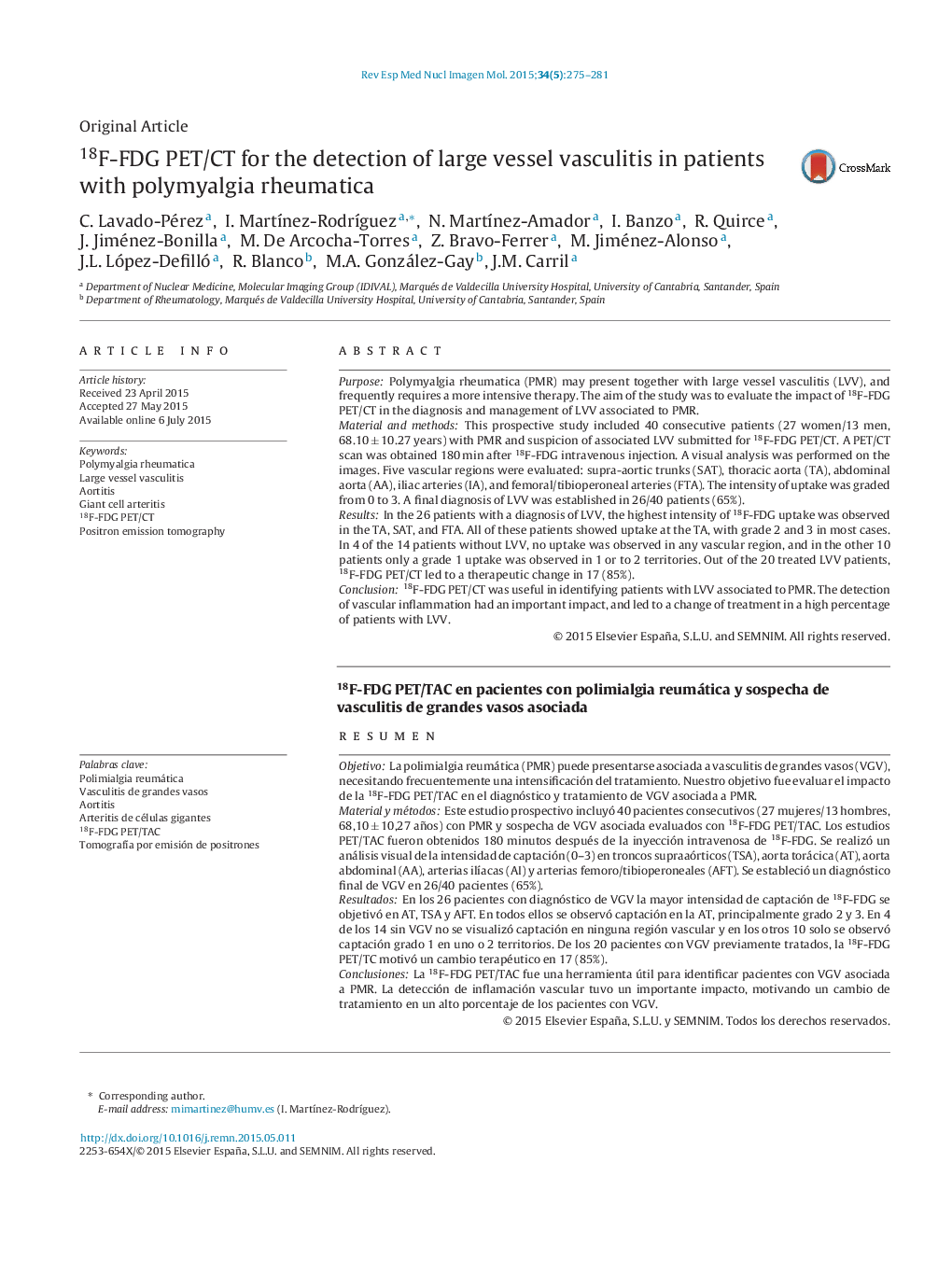| Article ID | Journal | Published Year | Pages | File Type |
|---|---|---|---|---|
| 4249739 | Revista Española de Medicina Nuclear e Imagen Molecular | 2015 | 7 Pages |
PurposePolymyalgia rheumatica (PMR) may present together with large vessel vasculitis (LVV), and frequently requires a more intensive therapy. The aim of the study was to evaluate the impact of 18F-FDG PET/CT in the diagnosis and management of LVV associated to PMR.Material and methodsThis prospective study included 40 consecutive patients (27 women/13 men, 68.10 ± 10.27 years) with PMR and suspicion of associated LVV submitted for 18F-FDG PET/CT. A PET/CT scan was obtained 180 min after 18F-FDG intravenous injection. A visual analysis was performed on the images. Five vascular regions were evaluated: supra-aortic trunks (SAT), thoracic aorta (TA), abdominal aorta (AA), iliac arteries (IA), and femoral/tibioperoneal arteries (FTA). The intensity of uptake was graded from 0 to 3. A final diagnosis of LVV was established in 26/40 patients (65%).ResultsIn the 26 patients with a diagnosis of LVV, the highest intensity of 18F-FDG uptake was observed in the TA, SAT, and FTA. All of these patients showed uptake at the TA, with grade 2 and 3 in most cases. In 4 of the 14 patients without LVV, no uptake was observed in any vascular region, and in the other 10 patients only a grade 1 uptake was observed in 1 or to 2 territories. Out of the 20 treated LVV patients, 18F-FDG PET/CT led to a therapeutic change in 17 (85%).Conclusion18F-FDG PET/CT was useful in identifying patients with LVV associated to PMR. The detection of vascular inflammation had an important impact, and led to a change of treatment in a high percentage of patients with LVV.
ResumenObjetivoLa polimialgia reumática (PMR) puede presentarse asociada a vasculitis de grandes vasos (VGV), necesitando frecuentemente una intensificación del tratamiento. Nuestro objetivo fue evaluar el impacto de la 18F-FDG PET/TAC en el diagnóstico y tratamiento de VGV asociada a PMR.Material y métodosEste estudio prospectivo incluyó 40 pacientes consecutivos (27 mujeres/13 hombres, 68,10 ± 10,27 años) con PMR y sospecha de VGV asociada evaluados con 18F-FDG PET/TAC. Los estudios PET/TAC fueron obtenidos 180 minutos después de la inyección intravenosa de 18F-FDG. Se realizó un análisis visual de la intensidad de captación (0–3) en troncos supraaórticos (TSA), aorta torácica (AT), aorta abdominal (AA), arterias ilíacas (AI) y arterias femoro/tibioperoneales (AFT). Se estableció un diagnóstico final de VGV en 26/40 pacientes (65%).ResultadosEn los 26 pacientes con diagnóstico de VGV la mayor intensidad de captación de 18F-FDG se objetivó en AT, TSA y AFT. En todos ellos se observó captación en la AT, principalmente grado 2 y 3. En 4 de los 14 sin VGV no se visualizó captación en ninguna región vascular y en los otros 10 solo se observó captación grado 1 en uno o 2 territorios. De los 20 pacientes con VGV previamente tratados, la 18F-FDG PET/TC motivó un cambio terapéutico en 17 (85%).ConclusionesLa 18F-FDG PET/TAC fue una herramienta útil para identificar pacientes con VGV asociada a PMR. La detección de inflamación vascular tuvo un importante impacto, motivando un cambio de tratamiento en un alto porcentaje de los pacientes con VGV.
